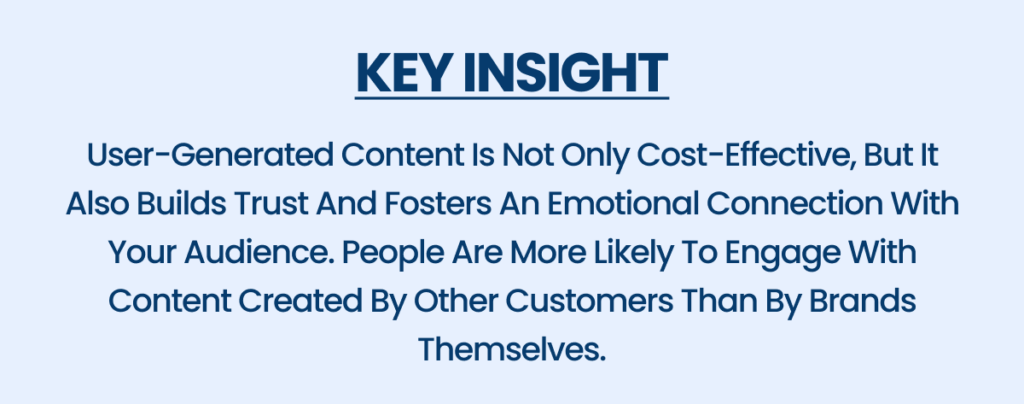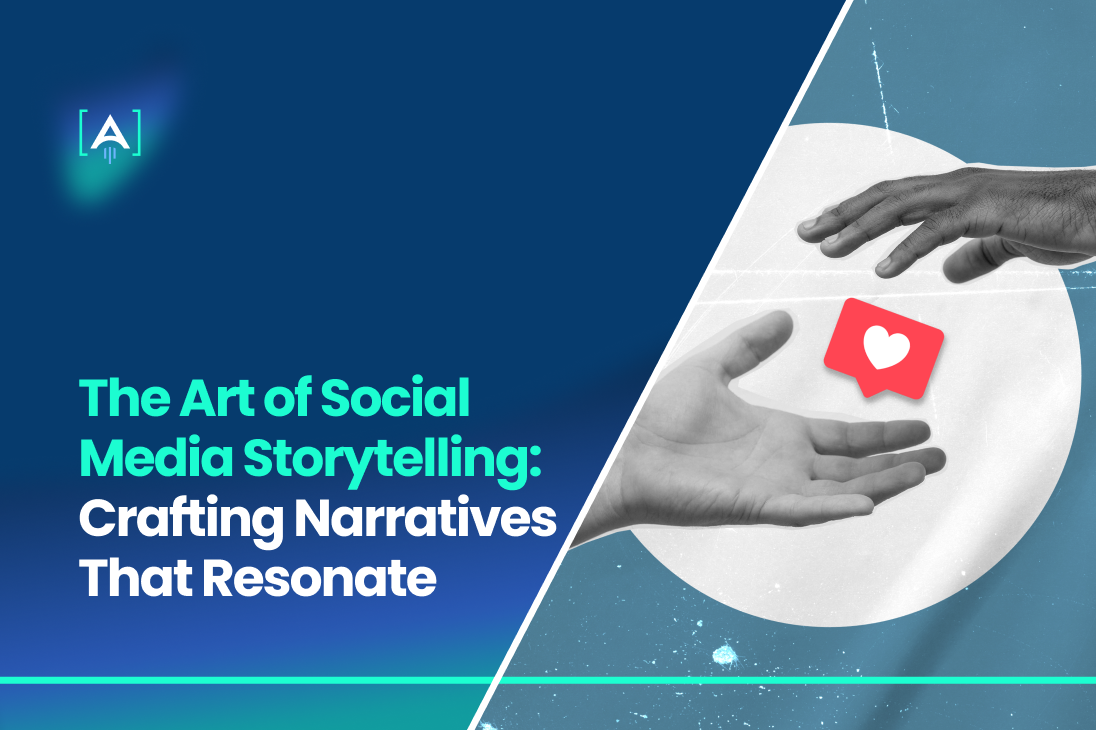In the 1950s, a man with a white suit, a small kitchen, and a secret chicken recipe began visiting restaurants across America.
He wasn’t a big-time entrepreneur or marketing genius—just a man with a vision and a story.
Though faced with countless rejections, he persevered, cooking his signature fried chicken and telling his brand’s story to anyone who would listen. His persistence paid off.
He wasn’t just selling food; he was sharing a piece of his legacy.
Today, we know that humble cook and his fried chicken empire as KFC.
The key to his success wasn’t just the secret recipe but a compelling narrative that resonated with his target audience.
In today’s digital world, social media storytelling serves the same purpose, transforming businesses into unforgettable brands.
For modern CEOs, mastering storytelling in social media is essential to creating brand stories that leave a lasting impression.
Whether through social media marketing campaigns or engaging social media posts, your brand’s story needs to resonate across multiple social media platforms.
Every great brand begins with a story. Yours is waiting to be told.
Let’s dive into how crafting a narrative on social media can create loyal followers and drive growth for your business.
Chapter 1: From Data to Drama – Crafting the Core Story
Turning Numbers into Emotion: The Magic Formula of Narrative
Business metrics often feel like cold, hard facts.
But within those numbers lies the heart of a story waiting to be told.
To succeed in social media storytelling, you need to turn data into a compelling narrative that speaks to your audience on an emotional level.
Let’s explore how CEOs can transform dry statistics into engaging stories that connect.
Find the Human Element in the Data
Behind every number is a person—a customer, a partner, an employee.
Your job is to find the human side of that data. For example:
- Customer Growth: Instead of saying, “We grew by 200%,” explain how your product changed lives. Highlight personal stories of customers whose challenges were solved by your service.
- Milestones: Don’t just share that you hit 1 million downloads. Tell the story behind it—what obstacles did you overcome? How did your team persevere?
Tip: Use customer testimonials to create powerful social media stories that highlight real people behind the numbers.
Create Emotional Connections from Data
While numbers are factual, they need to create emotional connections with your audience.
Think of companies like Tesla or Apple:
- Tesla doesn’t just talk about battery range. They create stories about a greener future where your family’s trip is emissions-free.
- Apple doesn’t focus on product specs. They emphasize how their devices let you express yourself, build, and connect.
When you craft your brand story, make sure every data point connects to how it will make your target audience feel.
Source: Tesla
Emotion is what turns a number into a compelling story.
Tell a Transformation Story
Data is a journey. Show how your business has evolved over time.
- Before and After: Share where your company started and how far it’s come. Use the challenges and successes as a compelling narrative that resonates with your audience.
- Customer Transformations: How did your product help customers succeed? These success stories are the backbone of powerful social media storytelling campaigns.
Example: Tesla didn’t just say, “We sold 1 million cars.” They built a narrative around revolutionizing the automotive industry and making sustainability mainstream.
Use Visuals to Make Data Engaging
Numbers can be hard to digest. Use visual storytelling to make your data engaging and accessible:
- Infographics: Create easy-to-understand visuals that summarize complex information.
- Videos: Show how a particular number—whether sales or customer growth—affects real people’s lives.
Apple is a master at using visuals to simplify complex ideas. They don’t just release specs; they show how their devices enhance everyday life.
Source: Apple
Make Data Personal and Relatable
Your data should connect to your audience on a personal level:
- Highlight customer success in relatable terms. Don’t just say, “We saved clients time”—share how an entrepreneur used those extra hours to grow their business.
- Use social media retargeting to bring your brand’s story back to customers who’ve shown interest.

Build Trust with Data
Data adds credibility to your brand stories.
Share key numbers during social media audits or after social media a/b testing to show transparency and results.
Highlighting numbers while telling a compelling narrative helps build trust with your target audience.
Chapter 2: Heroes and Villains – Every Story Needs a Conflict
The Hero’s Journey: How Conflict Sparks Engagement
Every great social media storytelling effort needs a hero—and a villain.
It’s the tension between these two that captures attention and keeps your audience engaged.
Whether your business is solving a major pain point for customers or overcoming internal challenges, conflict is the driving force that transforms a passive story into a compelling narrative.
The Role of Conflict in Storytelling
Without conflict, stories fall flat. Just like every hero needs a villain, your brand story needs a problem to solve.
For businesses, this means identifying the obstacles your target audience faces—and positioning your product or service as the hero that swoops in to save the day.
Example: Think about how Apple presented the iPhone. The “villain” was the clunky, slow mobile devices that made internet browsing and app usage difficult. The iPhone became the “hero” by solving this, offering a seamless user experience that changed the way we use technology.
Source: Apple
Your Product as the Hero
To craft stories that resonate, start by identifying the conflict your customers face.
This could be anything from inefficiencies in their workflow to frustrations with current solutions.
When you frame your product or service as the hero, you show your audience how you’re solving their problems.
- Identify the Problem: What are the pain points your customers experience? This conflict is the heart of your story.
- Position Your Solution: Your product or service should be the hero that solves these problems and makes life easier for your customers.
Social Media Tip: In your social media posts, always position your product or service as the problem-solver. Showcase how it addresses a specific challenge and creates an emotional connection with your audience.
Building a Journey Around Conflict
The hero’s journey is what keeps audiences hooked.
Just like in movies, your brand’s story should follow a similar path: identifying the problem, facing challenges, and ultimately achieving success.
Here’s a simple framework for creating narratives around conflict:
- Introduction: Introduce the “villain”—the problem your customers face.
- Challenge: Showcase the struggle. Maybe your customers have tried other solutions that failed.
- Resolution: Your product or service swoops in as the hero, solving the problem and offering a satisfying conclusion.
Using Real Challenges as Storytelling Fuel
Your business’s own challenges are ripe for storytelling.
Whether you’ve struggled with scaling, navigating digital marketing trends, or managing growth, sharing these stories makes your brand more relatable and human.
Your audience will connect with the real-life hurdles you’ve overcome.
Example: Let’s say your company faced the challenge of handling rapid growth, which resulted in communication breakdowns. By refining your systems and investing in a more agile workflow, you not only solved your internal problems but also improved how you serve customers. This transformation can be shared across social media platforms as part of your social media storytelling campaigns.
Use Visual Storytelling to Show the Conflict
Showing conflict visually is a powerful way to connect with your audience engaged on social media platforms like Instagram or Facebook.
Use professional photography or video content to visually represent the problem and the solution.

Engage Your Audience in the Story
To make your story relatable, ask your audience to participate in the narrative.
Use interactive features like polls, user-generated content campaigns, or live sessions to get their feedback on the problems they face and how they think your brand can help.
- User-generated content: Encourage your customers to share their own success stories with your product, positioning them as heroes in their own right.
- Social media lead generation: Collect insights from these stories to further refine your narrative and offerings.
Chapter 3: The Power of Visual Storytelling
More Than Words: The Power of Visuals in Crafting a Brand Narrative
In today’s fast-paced digital world, your audience is scrolling past hundreds of posts every day.
How can you make them stop, engage, and remember your brand story?
The answer lies in visual storytelling.
While words can tell a story, visuals can create engaging stories that capture attention instantly and leave a lasting impression.
Why Visuals Matter in Storytelling
Humans are naturally drawn to visuals.
In fact, studies show that the brain processes images 60,000 times faster than text.
When it comes to social media platforms like Instagram, TikTok, and Pinterest, the success of your social media storytelling campaigns depends heavily on how well you use visuals.
- Videos evoke emotion and provide a dynamic way to share your message.
- Photos can convey your brand’s identity and connect with your audience on a personal level.
- Infographics simplify complex ideas and make data digestible, turning facts into compelling stories.
For CEOs, visuals are no longer optional—they are essential to crafting narratives that resonate with today’s audience.
Elevating Your Brand Story with Visuals
In social media marketing, visuals do more than just decorate—they amplify your message.
Here’s how you can use different types of visual content to enhance your brand’s story:
- Videos: Create visual storytelling experiences that show your brand in action. Think product demos, customer testimonials, or even behind-the-scenes content. This helps your audience form an emotional connection with your brand.
- Photos: Use professional-quality photos that highlight your product, team, or events. By visually showcasing your brand’s values and company culture, you build trust and foster brand loyalty.
- Infographics: Turn data into engaging stories by visualizing key stats or trends. This is especially effective for sharing complex information like sales data, customer feedback, or social media insights in a simple and attractive way.
Leveraging Platforms for Visual Storytelling
Some social media platforms are particularly designed for visual storytelling, and it’s essential to tailor your content for each.
Here’s how you can leverage leading platforms to elevate your brand stories:
- Instagram: Use Instagram Stories, posts, and IGTV to share short, bite-sized engaging stories. Instagram is perfect for visually appealing content, whether it’s product showcases, customer testimonials, or creative lifestyle photography.
- TikTok: TikTok is all about quick, engaging video content. Use this platform to create fun, authentic videos that highlight your brand’s personality and culture. Brands like Nike use TikTok to create interactive features and challenges that engage their target audience.
- Pinterest: A great platform for businesses with visually driven products, Pinterest allows you to curate boards that tell a cohesive brand story. Whether you’re in fashion, home decor, or travel, Pinterest is the ideal place to showcase high-quality images that represent your brand’s identity.
Visual Storytelling Tips for CEOs
Here’s how you can create visuals that elevate your storytelling:
- Keep it Simple: Don’t overload your visuals with too much information. Focus on one clear message, whether it’s the benefits of your product or a glimpse of your company’s values.
- Be Consistent: Your visuals should consistently reflect your brand’s personality. Use a specific color palette, tone, and style to create a solid brand presence across all social media platforms.
- Show, Don’t Tell: Use visuals to show your audience what your brand stands for rather than telling them. For example, instead of saying “We care about sustainability,” share images or videos of your eco-friendly practices in action.

How Leading Brands Use Visual Storytelling
Brands like Nike, Coca-Cola, and Airbnb have mastered the art of visual storytelling.
They don’t just sell products; they sell experiences and emotions through visually appealing content. Here’s how they do it:
- Nike uses short, impactful videos that focus on athletic achievement and motivation. These engaging stories inspire viewers to push their limits, creating a strong connection between the brand and its audience.
Source: Nike
- Airbnb tells compelling narratives about travel and connection through user-generated content. Sharing real stories from hosts and guests creates a sense of community and belonging.
Source: Airbnb
- Coca-Cola incorporates vibrant imagery in their social posts that connect their brand with moments of happiness, family, and friendship. Their visuals are consistent with their brand voice and easily recognizable.

Source: CocaCola
Chapter 4: Building a Loyal Audience – Interaction is Key
Engagement: Where Your Story Meets Theirs
Storytelling on social media platforms isn’t just about broadcasting your brand’s story—it’s about inviting your audience to be a part of it.
The days of one-sided marketing are over.
To build a loyal audience, you need to engage, interact, and make your followers feel like they’re contributing to the brand story.
In other words, social media storytelling is a two-way street where the magic happens when your story meets theirs.
Why Engagement Matters in Storytelling
Storytelling in social media is most powerful when it creates a sense of participation.
Today’s consumers want to interact with brands they follow, not just passively consume content.
Whether it’s through comments, user-generated content, or live interactions, getting your audience involved can turn casual followers into devoted fans.

Interaction Drives Loyalty
Engaging your audience turns them from observers into participants.
Here are a few ways to build that interaction:
- Ask Questions: Simple yet effective. Pose questions in your social media posts that call out followers to share their thoughts or experiences related to your brand story. This gives your audience a voice in the narrative.
- Create Polls and Surveys: Use interactive features like polls on Instagram or Twitter to gather opinions. Let your audience decide on things like your next product feature or the theme for your upcoming campaign.
- Host Live Sessions: Use live video to interact in real-time. Whether it’s a behind-the-scenes tour, a Q&A with the CEO, or a product demo, live content makes your storytelling efforts feel personal and spontaneous.
Social Media Tip: Engagement isn’t just a bonus—it’s an essential part of crafting narratives that your audience can connect with on a personal level. The more they interact, the more invested they become in your brand’s story.
Making Your Audience the Star of the Story
One of the most effective ways to foster brand loyalty is by allowing your audience to contribute to your social media storytelling campaigns.
When they see their own stories or experiences reflected in your brand, they feel more connected and valued.
Example: Nike’s User-Generated Content Campaigns
Nike has mastered the art of user-generated content campaigns, using real customer stories to build a sense of community.
Source: Nike
Instead of just showcasing professional athletes, Nike features everyday users who share their fitness journeys, personal achievements, and struggles.
By encouraging customers to share their own personal stories, Nike makes them feel like they’re part of the brand’s mission.
Amplify Authentic Stories with User-Generated Content
One of the most powerful storytelling tools in your arsenal is user-generated content.
Authenticity is key to building trust, and there’s nothing more genuine than real customers sharing how your brand has impacted them.
By sharing these compelling stories across your social media platforms, you create a sense of community and validation that goes far beyond traditional marketing.
- Repost Customer Content: When customers share photos, videos, or testimonials about your product, repost them with permission. This shows you’re listening and appreciating their contribution to your brand’s story.
- Run Competitions: Encourage users to create and share content by running themed contests. For example, ask followers to submit photos using your product in creative ways and feature the best entries in your social media content curation.

Use Data to Drive Engagement
Engagement is a two-way conversation, but data can help you understand how to keep that conversation going.
Use tools like cross-channel analytics and social media a/b testing to see what kind of posts resonate most with your audience.
Are they more likely to engage with photos, videos, or polls?
Is there a specific time of day when your social media posts get the most interaction?
By analyzing these engagement metrics, you can fine-tune your strategy to foster even deeper connections with your followers.
Build Long-Lasting Relationships
Engagement doesn’t end after one interaction—it’s about building relationships over time.
Consistency is key here. Continue to involve your audience in your brand stories, give them shout-outs, and engage with their content.
- Follow Up: After running a contest or sharing user-generated content, keep the conversation going. Respond to comments, ask follow-up questions, and show that you care about their input.
- Thank Your Audience: Never underestimate the power of a simple thank you. Whether you’re responding to a comment or reposting user content, make sure your followers know you value their participation.
Create Your Legacy and Your Story with [A] Growth Agency
At the heart of every successful business is a story that resonates.
As a CEO, your legacy isn’t just built on products or profits—it’s built on the brand stories you create and share.
Your social media storytelling isn’t just a marketing tactic; it’s the foundation of how your audience will remember you.
Whether it’s visual storytelling that captures attention, engaging your followers in user-generated content campaigns, or crafting a compelling narrative that brings your product to life, each story you tell contributes to your brand’s legacy.
When you invite your audience into your narrative, you build not simply a customer base but a community of loyal advocates who believe in your mission.
Now is the time to make your brand’s story unforgettable.
By partnering with a top-tier Social Media Marketing Agency like [A] Growth, you can turn your vision into a legacy that lasts.
We specialize in helping businesses like yours craft and share powerful stories that drive engagement, foster loyalty, and create lasting connections.
Let [A] Growth help you shape your legacy through social media storytelling.
Your story is waiting to be told. The world is waiting to listen.

